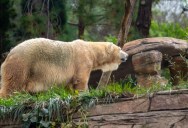The Polar Bear/Grizzly Hybrids Known As Pizzlies Signal A Worrying For The Future Of The Arctic

The polar bear is in big trouble, because climate change is affecting the polar ice caps with such devastating speed. And while you might be inclined to think the appearance of “pizzlies,” or “grolar bear” hybrids would be a good thing, in reality it’s one more foreboding sign in a long line of the same.
These bears are hybrids of grizzly bears and polar bears, and as habitats change and shift in the northernmost stretches of our world, scientists believe we will see more of them in the near future. At a full-grown weight of 1800 pound and height of nearly 11 feet, polar bears are quite a bit larger than the grizzly, which tops out at around 600 pounds.
Obviously, their fur is different colors and their snouts are also shaped slightly different.

Gloria Dickie, an environment journalist, says these have been popping up for awhile, but no one was for sure what they were looking at.
“They look like a mishmash of polar bears and grizzly bears. Typically, they look like a white-ish or blonde-ish grizzly bear. They have grizzlies’ dish-shaped faces and those long grizzly bear claws, but they’re mostly white with patches of brown.”
They were first confirmed by biologists in 2006, and in 2017, a study traced eight hybrid bears to a single female polar bear who had mated with two male grizzly bears. Most of the research has come from hunters who have killed hybrid bears, and there have been several documented second-generation hybrids that are the offspring of a pizzly and a grizzly.
That said, Dickie believes there’s no real way to know how common this mating is, because “we’re not frequently in places where these hybrids would be living.”
Historically, the bears have had an adversarial relationship, competing over food and territory, so this interbreeding is kind of surprising. Grizzly bears live across Western Canada and Alaska, along with some sightings in Idaho, Montana, Washington, and Wyoming.
Polar bears live in the Arctic region, with a range that extends all the way from the North Pole, Canada, Alaska, Greenland, Russia, And Svalbard in Norway. For a long time, the only places where these natural ranges overlapped were in Western Canada and Alaska, and then usually only during the warmer months.
With the melting ice becoming more of a problem at different times of the year, and in some cases melting altogether, the polar bear has had to expand its territory.

Warming temperatures are also pushing the grizzly bear further north, meaning these two species are encountering each other more and more.
“These two animals that never really ran into each other and are now being forced to share closer quarters. I guess sometimes that can make for some ‘fun times,’ but it’s also a signal that the Arctic is no longer as it once was.”
The population of polar bears is already in dire straits, and this actually isn’t good news, as the interbreeding would probably eventually breed them into extinction.
Definitely not good news.
While we’re here, though, I have to say I prefer “grolar bear” to pizzly.
The latter just doesn’t seem appropriate for an animal that could rip your whole face off.
Thought that was fascinating? Here’s another story you might like: Why You’ll Never See A Great White Shark In An Aquarium

Sign up to get our BEST stories of the week straight to your inbox.




